A Deep Dive into the AAVE V4 Upgrade: Reshaping Lending with Modularity — Can the AAVE Token Make a Comeback?
On the evening of July 25th, AAVE founder Stani’s announcement about the upcoming launch of AAVE V4 immediately drew significant attention and sparked heated debate across the market, while the recent controversy between AAVE and WLFI over a proposed 7% token allocation has also sparked heated debate across the market.
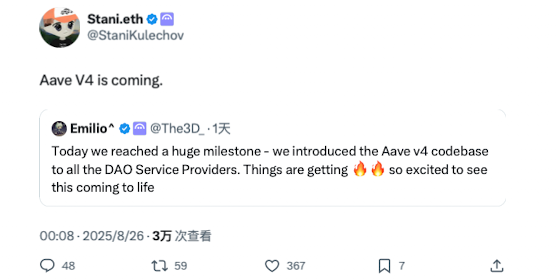
Suddenly, market focus turned to AAVE, the well-established lending protocol.
Although the dispute between AAVE and WLFI has yet to reach a definitive conclusion, what’s unfolding behind the drama suggests another reality—new tokens are constantly emerging, but AAVE continues to be a key player.
With more tokens entering the market and persistent on-chain lending demand, AAVE stands out thanks to its strong fundamentals and compelling growth catalysts.
This V4 update could provide a clearer picture of AAVE’s powerful competitive advantage in DeFi and shed light on the underlying drivers behind its rising activity.
From Lending Protocol to DeFi Infrastructure
When considering AAVE V4, the first question to ask is: Why is the market looking forward to this upgrade?
Since its origins as ETHLend in 2017 to now being a DeFi powerhouse with $3.86 billion in TVL, every AAVE update has focused on optimization, consistently impacting asset liquidity and use cases on-chain.
AAVE’s version history essentially mirrors the evolution of DeFi lending itself.
When V1 launched in early 2020, DeFi’s total TVL was under $1 billion. AAVE shifted from the P2P matching model to liquidity pools, turning lending into instant execution instead of waiting for counterparties. This innovation helped AAVE quickly gain market share.
V2, released at the end of 2020, introduced flash loans and tokenized debt positions. Flash loans fueled arbitrage and liquidations, driving protocol-generated revenue. Tokenized debt positions enabled position transfers, paving the way for future yield aggregators. V3, in 2022, focused on cross-chain integration, connecting assets from multiple chains and facilitating broader liquidity.
AAVE now serves as the benchmark for pricing in DeFi. Protocols consult AAVE’s supply-demand curves when setting rates, and new projects often calibrate collateral ratios using AAVE’s parameters.
Yet, despite serving as critical infrastructure, V3’s architecture is running up against clear limits.
The biggest issue is fragmented liquidity. AAVE boasts $6 billion TVL on Ethereum, $440 million on Arbitrum, and less on Base. Each network works as a stand-alone silo, limiting capital flow and reducing efficiency—especially stifling smaller ecosystem growth.
The second challenge is slow innovation. New features must pass the full governance cycle, often taking months. In a fast-moving DeFi environment, this timeline lags far behind market needs.
The third issue is a lack of customization. RWA platforms require KYC, GameFi demands NFT collateral, institutions want segregated pools. V3’s unified structure struggles to accommodate divergent requirements; it’s all or nothing, with no flexibility.
That’s why V4’s core goal is to transform AAVE from a robust but rigid product into a flexible, open platform.
V4 Upgrade
Public sources confirm that V4’s main innovation is the “Unified Liquidity Layer,” based on a Hub-and-Spoke architecture that revamps technical design and business models alike.
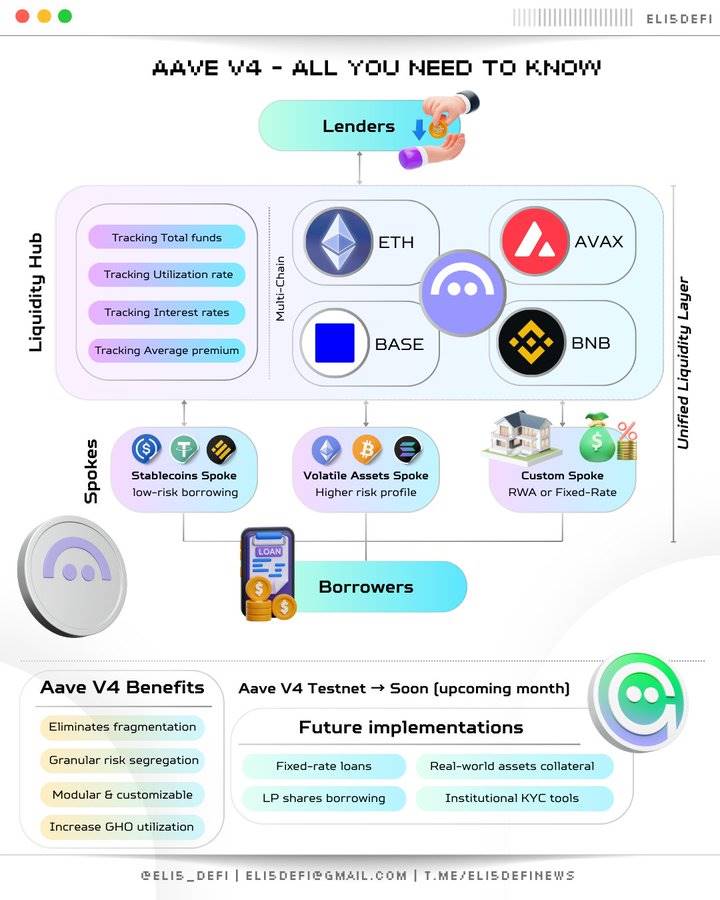
Image credit: @Eli5DeFi
Hub-and-Spoke: The solution to competing priorities
In essence, the Hub consolidates liquidity, while Spokes facilitate specific use cases. Users always interact via Spokes; each sets its own rules and risk parameters.
What does this accomplish? AAVE no longer needs to apply one rule for everyone; unique Spokes can address distinct requirements.
For example, Frax Finance could launch a Spoke only accepting frxETH and FRAX with aggressive parameters; at the same time, an “Institutional Spoke” might accept only BTC and ETH, require KYC, and offer lower interest rates.
Both Spokes tap into the Hub’s liquidity but keep risks compartmentalized.
This architecture enables deep, unified liquidity alongside risk segregation; central governance with bespoke customization. Previously at AAVE, these features conflicted. With a Hub-and-Spoke model, they work together.
Dynamic Risk Premiums
On top of architecture upgrades, V4 introduces a dynamic risk premium mechanism that overhauls how lending rates are set.
Instead of V3’s standard rates, V4 adjusts interest dynamically based on collateral quality and market liquidity. For instance, highly liquid assets like WETH get base rates, while more volatile ones like LINK pay extra premiums. Smart contracts handle these adjustments automatically, boosting protocol security and ensuring fair borrowing.
Smart Accounts
V4’s smart accounts let users operate more efficiently. Previously, users juggled wallets across chains and managed complex positions. Now, a single wallet can oversee multi-chain assets and lending strategies, cutting operational hassle.
One user can tweak WETH collateral on Ethereum and manage loans on Aptos—all from one dashboard, with no manual cross-chain transfers. This streamlined approach benefits both retail and institutional DeFi participants.
Cross-Chain & RWA: Expanding DeFi’s Reach
V4 uses Chainlink CCIP for instant cross-chain transactions, supporting non-EVM blockchains like Aptos—making asset onboarding seamless. For example, users can leverage Polygon assets for collateral, borrow on Arbitrum, and execute all actions in one transaction. The integration of real-world assets (RWA), such as tokenized Treasuries, opens DeFi to institutional funds. This expands AAVE’s universe and brings greater inclusivity to on-chain lending.
Market Response
Despite this week’s sharp downturn across crypto, AAVE’s rebound today has outpaced other major DeFi tokens.
Within 24 hours after the recent drop, AAVE’s trading volume hit $18.72 million, far exceeding UNI’s $7.2 million and LDO’s $3.65 million, indicating strong investor confidence in protocol innovation. Increased trading activity has further enhanced liquidity.
TVL gives a direct snapshot of market confidence. Compared to early August, AAVE’s TVL spiked 19% this month to nearly $7 billion—a new all-time high, and No. 1 on Ethereum. This surge is well above DeFi industry averages, and it underscores the success of AAVE V4’s multi-asset strategy, hinting at growing institutional participation.
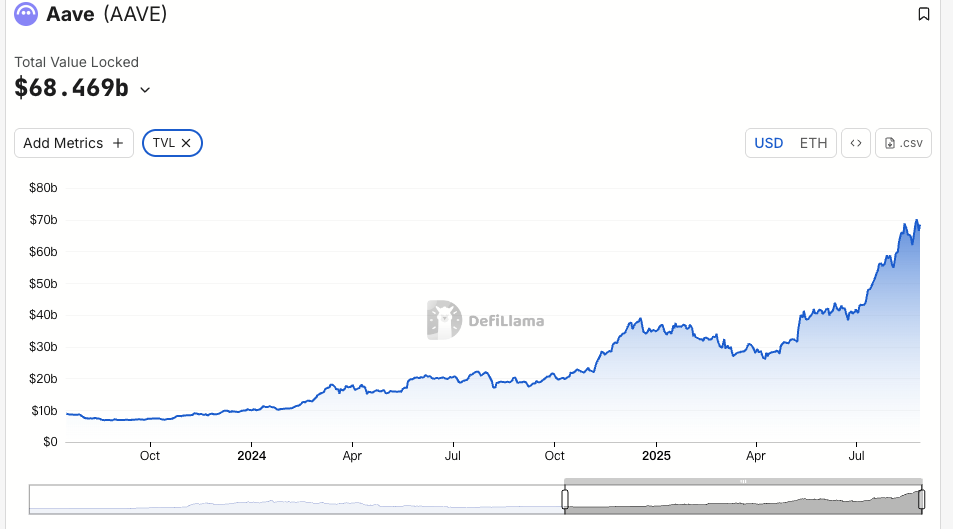
TokenLogic reports that AAVE’s net assets excluding AAVE token holdings have hit a record $132.7 million, up about 130% year-over-year.
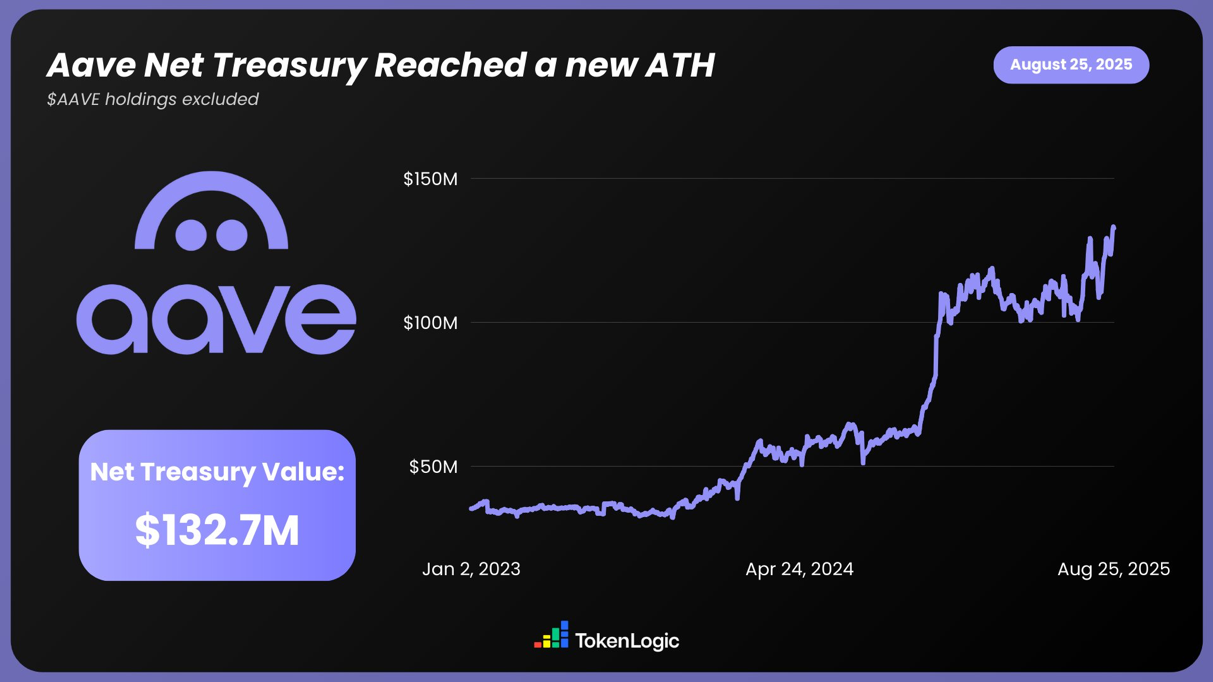
On-chain data show that as of August 24, AAVE’s open contracts totaled over $430 million—a six-month high.

Beyond the data, AAVE’s V4 upgrade has sparked broad discussion within the community. The V4 preview has earned widespread support—particularly for capital efficiency and DeFi composability—highlighting new possibilities and future growth.
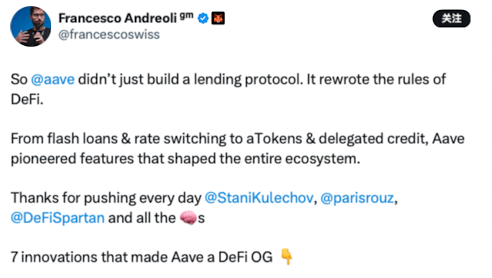
DeFi’s Next Chapter
Based on all the updates disclosed so far, AAVE’s latest upgrade could once again lift the DeFi sector to new heights. Modular architecture, cross-chain expansion, and RWA integration have not only fueled market optimism but have also pushed both price and TVL upward.
AAVE founder Stani, too, is evidently confident about V4’s potential to reshape the DeFi landscape.

The arrival of a crypto bull market could give AAVE the liquidity boost it needs to reach new heights and unlock unprecedented possibilities.
Disclaimer:
- This article is reprinted from [TechFlow]. Copyright belongs to the original author [伞,深潮 TechFlow]. For any concerns regarding republication, please contact the Gate Learn team, which will address your concerns promptly and appropriately.
- Disclaimer: The views and opinions presented in this article are solely those of the author and do not constitute investment advice.
- Other language versions have been translated by the Gate Learn team and may not be reproduced, distributed, or plagiarized without explicit acknowledgment of Gate.
Related Articles

In-depth Explanation of Yala: Building a Modular DeFi Yield Aggregator with $YU Stablecoin as a Medium

Sui: How are users leveraging its speed, security, & scalability?

What is Stablecoin?

Arweave: Capturing Market Opportunity with AO Computer

Exploration of the Layer2 Solution: zkLink
